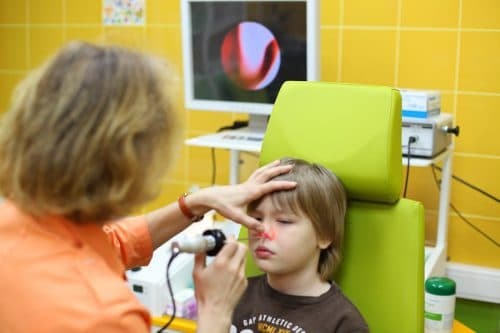
Inflammation of adenoids is a pathological process that affects the nasopharyngeal tonsil. Diagnose the disease mainly in children. The treatment process can take place in two ways - conservative and surgical. The first method is used when the disease is at an early stage. If there is a risk of complications, the doctor decides on the operation.
Contents
- 1 The essence of the operation
- 2 Indications
- 3 How is
- 3.1 Classical
- 3.2 Endoscopic operation
- 4 Rehabilitation period
- 5 Possible complications
- 6 Reviews
The essence of the operation
Adenotomy is an operative method of therapy, the essence of which is to remove adenoids. Surgeons often call it "streaming".This procedure is considered the easiest in ENT surgery. Adenotomy is not an emergency and urgent surgery. As a rule, they prepare it for planning, and before that the patient is assigned the necessary diagnostics. The duration of the operation does not exceed 10 minutes, and it is performed in the morning.

On photo-adenotomy in children
After adenotomy, the patient is still at the disposal of doctors for 5 hours, and in the evening can go home. There are rare cases when he is left to spend the night in a hospital. This occurs when there are complications such as bleeding or side effects after anesthesia.
Indications
Is it obligatory to remove adenoids to a child? To conduct the operation is necessary in the case when conservative therapy has not given the proper effect or there is a risk of complication development. For adenotomy, the patient should have the following symptoms:
- Nasal breathing difficulties .The baby more and more breathes in the air with the mouth, as a result of which the mucous membranes dry up, the ARVI and complications appear after them. In addition, the inability to breathe through the nose leads to a disturbance in the night's sleep, the child is always irritable and tired.
- Delayed breathing during sleep .This symptom carries a life-threatening crumbs. It arises because of a lack of oxygen in the brain.
- The otitis of the chronic form .Since the adenoids are enlarged, neither cover the auditory tube, which leads to inflammation in the middle ear. During the year, the baby has otitis media 4 times, and the hearing is worse.
- Pathological changes in the facial skeleton .In medical terminology, there is such a thing as an "adenoid face."The increased size of the adenoids leads to abnormal changes in the bones of the jaw and face.
- Malignant tumors of .Situations when the adenoid tissue grew into a malignant tissue, existed extremely rarely.
On video adenotomy in children:
How is the
carried out The process of adenoid removal in children can occur with the help of two types of adenotomy: classical and endoscopic.
Classical
For carrying out manipulation the doctor uses a specific instrument, which is presented in the form of a knife. Sometimes it can be equipped with a box. In not and will add the deleted tissue. Manipulation is performed when the patient is sitting. The instrument is inserted through the mouth of the baby over the soft sky, and then it is directed upwards, to the arch of the nasopharynx. With the help of this clear movement specialist removes the affected tissue through the mouth.
For local surgery, local or general anesthesia is used. Each kind of anesthetic has its advantages and disadvantages.
If local anesthesia is used, Novokain, Lipokain is injected in the form of a spray or drops. You need to do this half an hour before the procedure. Also, sedative drugs are administered so that the baby normally undergoes surgery.
On video-classical adenotomy in children:
Local anesthesia is used right before excision of adenoids. This method of anesthesia is considered the most optimal for children, since after the operation there is no post-cankeric period.
 What to do when a child has adenoids, and does not breathe through the nose, is described in great detail in this article.
What to do when a child has adenoids, and does not breathe through the nose, is described in great detail in this article.
How the treatment of chronic adenoiditis is treated, and which medications are the best, is described in great detail in this article.
What are the most common symptoms of allergic adenoiditis in children, you can find out from this article: http: //prolor.ru/n/ bolezni-n /adenoidit/ u-detej-simptomy.html
And here's how the acute adenoiditis is treated, and how quickly you can cope with this problem,in this article.
Endoscopic operation
Today this method is most often used to remove adenoids. This operation allows you to remove the damaged tissues with great accuracy, but also does not lead to invasiveness. There are situations when children need to be re-manipulated to remove adenoid growths, because the pharyngeal tonsil can grow after adenotomy.
Conduct endoscopic adenotomy is advisable in cases where adenoids increase in size, and are concentrated along the wall of the mucosa. In this case, they prevent the baby from breathing normally and disturb the ventilation of the auditory tube. All this ultimately can lead to otitis and acquired conductive hearing loss.
On video endoscopic adenotomy in children:
Endoscopic surgery is performed under general anesthesia. Thus, it is possible to make the intervention invasive and more accurate. Duration of manipulation is about 10-20 minutes. After the introduction of the anesthetic medicine into the nasal cavity, an endoscope is inserted along the lower nasal passage. The first thing a specialist does is to inspect the adenoids, and then cut them off. For this purpose, he uses endoscopic devices. The choice of a specific instrument will depend on the equipping of the endoscopic device and the anatomy of the pharyngeal tonsil. Adenoids can also be removed through the oral cavity.
Rehabilitation period
After the surgical intervention in the first hours the child will be located in the hospital. If there are no complications, then on the same day in the evening he is sent home. After a couple of hours, the baby can be given food. In this case, the food should be puree, warm and not contain spices.
At home, the child must comply with bed rest. It will last a couple of days. And for several weeks you can not perform sports activities, outdoor games and any intense physical activity. To prevent the occurrence of bacteriological complications after surgery, the doctor appoints small patients to take antibacterial drugs.
On video recovery after adenotomy in children:
Possible complications of
After the operation to remove adenoids in small accents, there may be some complications:
- Relapse. This complication is one of the most frequent. After manipulation after some time, the tissue of the tonsils will expand, as a result of which it is necessary to repeat the operation.
- Bleeding. They can last up to 3 months, while they do not carry any danger at all. To alleviate the situation, the doctor prescribes vasoconstrictive drops and a drug to eliminate the common cold.
- Pain in the head. In the first days after surgery, the baby can feel headaches, general weakness and dizziness.
- Puffiness. The body must adapt and again learn to breathe freely with your nose. This leads to the development of otitis and edema.
- Temperature rise .This complication is due to the fact that during the operation there is a risk of developing otherworldly infections.
And here's how adenoids are treated in children without surgery, and what medicines are best and effective will help understand this article.
It will also be interesting to learn about how to drip thai oil in adenoids, and how effective this tool is.
How to treat adenoids 1 and 2 degrees in children, and how to cure it at home, with home remedies, will help understand this article.
And here is what folk remedy for adenoids is used most often and how quickly to cure such a problematic disease, is described in great detail in this article.
You may also be interested in learning about what to wash your nose with adenoids in children.
Reviews
- Marina, 35 years old: "When my child has an inflammation of the adenoids, the doctor at first did not send us for surgery. She prescribed us a certain list of drugs. We carried out all the recommendations, but we did not manage to overcome the unpleasant symptoms and the illness itself. Then we had an operation. Conducted it in a classical way with the use of general anesthesia. After the procedure, the child was in the hospital until evening, and then I took him home. Everything went well, there were no complications, which is why we are very happy. "
- Anna, 26 years old: "My daughter, 2 years ago, had surgery to remove adenoids. Performed under local anesthesia, but after manipulation a complication such as bleeding arose. I had to stay in the hospital for another day. Then we were discharged, but the doctor insisted that the child adhere to bed rest, took antibiotics and vasoconstrictive drops. Somewhere in 3 months the child's condition returned to normal. "
- Irina, 48 years old: "My granddaughter at the age of 9 years made endoscopic removal of adenoids. The weight passed very quickly and simply. The whole operation lasted 15 minutes. In the evening the granddaughter was at home. There were no complications. In addition to a slight rise in temperature. But the doctor allowed us to drink a fever-reducing medication and no more such phenomena occurred. "
Adenotomy is an effective and simple way to remove adenoids in children. This operation can be performed under general or local anesthesia, and in the evening the patient can go home. Of course, complications are not excluded, but if you follow all the prescriptions of the doctor, you can get rid of them very quickly.
